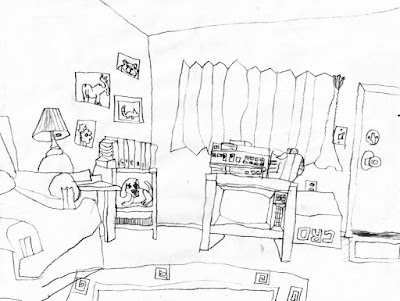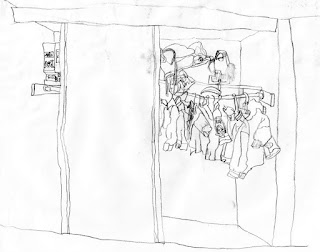
Continuing with Part 3 of our Expanding Drawing Skills series, we're going to draw our living space, or the details of the room that we are in. These types of drawings are called "interiors."
To draw an interior, all you need are a drawing pencil, a large soft eraser (white is best), and a drawing board if you have one. The drawing board allows you to relax on a couch or chair and set up your drawing surface at a comfortable angle.
First, observe the room and decide where to start. It often works well to start on one side of the room and work your way to the other side, such as left to right. Try to include as many details as possible. Remember that things nearest you "overlap" objects that are farther away.
Both of the drawings above are of the same living room, but drawn at different times and by a different artist. Can you tell? What parts of the room are the same? What is different?

Here is another interior drawing, this time of a bedroom. Is this a clean or a messy room? Is this a boys' or a girls' room? How can details help a drawing tell a story? Would you say that details make a drawing more interesting to look at?

Here is an open closet in the same bedroom. The only thing missing are the shoes!
(The artist said they were too messy to draw.)

This started out as a centerpiece drawing project from a book called Drawing With Children. The artist then completed the drawing by placing the centerpiece on the table in our kitchen. He added cabinets, drawers, chairs, and even our parakeet, Monet!
This interior drawing shows a corner of a classroom. Notice the toys in the 3-dimensional shelves, the posters on the wall, and the blocks laying on the floor.
When beginning an interior drawing, don't ever decide that the scene in front of you is "too hard."
Just start drawing, one object at a time. Use a piece of ordinary copy paper or drawing paper and fill it up to all four edges. Don't try to squeeze everything in. Just draw to the edges of the paper as through you are taking picture with a camera. Each time you draw an interior, the next one will be easier for you. Go ahead, give it a try!
Next: Our favorite Halloween Art Project Ideas you can try at home!



















